Hilary Rowley
Growing up in rural Central Otago, with parents who lived an almost self sufficient lifestyle, but in a pioneering 19th century way, was all I needed as a background to make me want to live that way too. Having passionately studied English, economics, politics and Geography in the ‘80’s, but then careering off on an altogether more alternative punk rock trajectory and never actually getting a qualification has left me with a lifelong interest in study, reading, and learning about everything, from any source. We currently live on ¾ of an acre of steep ex-gorse, buy very little food, and turn excess food into cash to buy our other needs. Our house is grid tied solar powered and water heated, and we want to continue on towards electric car ownership and battery power storage for a luxurious but low-input lifestyle.

A Blueskin Guide to Year-Round Gardening
Posted on 30 June 2015
by Hilary Rowley
“News Flash. Massive climate change event prevents food supplies from reaching Dunedin.” This is becoming an increasingly likely scenario. I had in mind the Christchurch earthquakes and the major snows a few years ago which closed all access roads to Blueskin Bay when I started to write this article, but this week alone we have had our own earthquake and a record rainfall which was so close to being a damaging flood.
During one of the snow events mentioned above, I walked down to the shop to buy some milk and found their fridge empty. This was after less than 12 hours of road closures. Fortunately it is not difficult to survive without milk, but if our food supplies were disrupted for any length of time, a lot of people would be in serious trouble. The risks to our supply chain seem to escalate at the same rate at which we source our food from further and further away. How silly is that? How vulnerable does it make you feel?
But the power can easily be back in our own hands. It is very possible to supply a good percentage of your household food from a suburban section. It is a very secure feeling to know you could probably last for weeks in an emergency, and the food that you are eating is organic and grown by either you or by people whom you trust.
Being able to supply food for your family in a disaster is not really about filling your cupboards with a 2 years supply of canned beans. How do you suppose people survived at all before shop-bought goods?
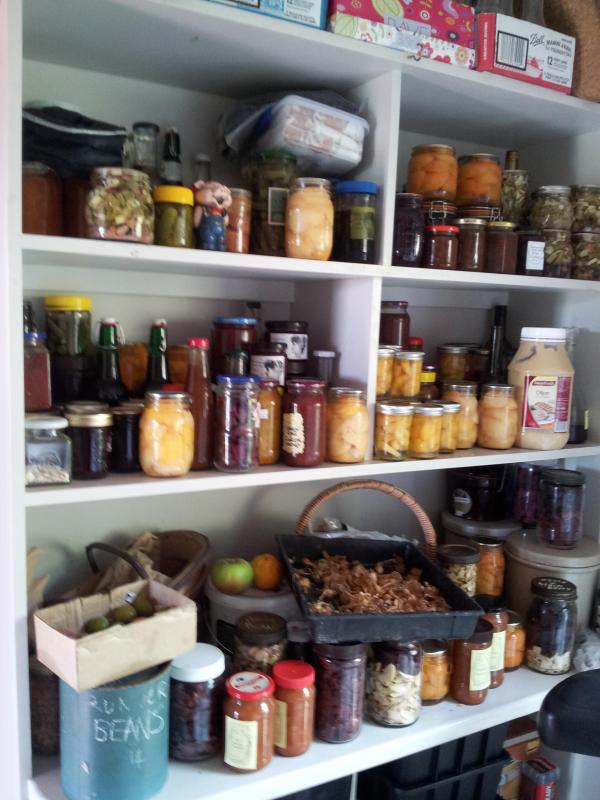
I have been reading a book about village life in medieval England. It was estimated that the population between 1066 and the 1300’s lived on about 18-30 acres per family whose average household size was 4.75 people. This land provided everything they needed: energy, transport, food, clothing, housing, furniture, tax, rents, healthcare… imagine that? It must have been a good amount of land as the population almost tripled in those 300 years.
Currently in New Zealand, the average household of 2.4 people could have around 20 acres each, based on 14,866,000 hectares of arable land including forestry and a population of 4.4 million (I converted these figures into acres).
If each household had 20 acres, we could probably survive quite nicely forever, but reality and human nature don’t allow this scenario. The reality for most of us is a suburban section. It is a challenge, but we can grow a lot of food and other supplies in a backyard. You can supplement your own land by using community gardens, road verges, paper roads, and waste ground. There are people with larger blocks who will lease some space.
You need to plan your garden as efficiently as possible, while juggling a seemingly endless number of factors. Choose crops you want to eat, and are possible to grow in your climate. Think about placement, keeping in mind the need for sun, frost tenderness, shelter from prevailing winds, different soil types, crop rotation, space required, companion planting… It all seems terribly complex, and it is, like life, complex. But you just do it. There is no perfect way. Don’t get too caught up with perfection. The only elements of your garden which you will really need to get right to first time are the fruit and nut trees. Consider them your framework. If they are already there, then you will just have to work around them.
Ideally your trees will need to be to the South and East of your section so as not to shade the rest of your garden. Look out for dwarf rootstock, which keeps them to a more manageable size, and prune or espalier to keep them to a size and shape which suits your space. Some trees such as pears and quinces (which have the same root stock) will cope with being planted in a septic tank outfall field, which is useful for Blueskin Bay. Treat your plantings like a class photo, with the tallest in the back row and smallest in the front row. As for varieties, the choice is yours, but ask around and see what other people have success with. Varieties which suit the climate will have fewer health problems, which is a bonus when you are growing organically. Keep in mind some trees need another of the same tree nearby for pollination.
Berries are a very efficient use of space, but must be covered against birds or you won’t know you even had a crop. We planted ours in one area so they would be easy to cover. We cover as needed with temporary netting but if you can afford it you could consider a permanent cage for all your berries.
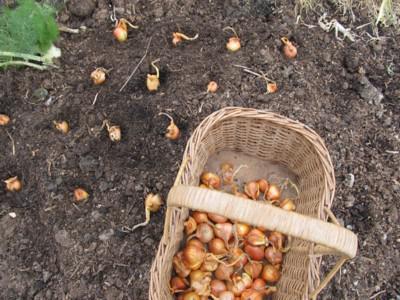
A dozen raspberry plants will produce a kilo every other day in season. I have had 10kg off one gooseberry bush. Some years, one variety of berry will do better than another, so grow a range to hedge your bets. For two people, three redcurrant bushes is probably too much. We have six black currants which have variable yields, but I think a family could probably use twelve without having an over supply.
Boysenberries, blackberries, marionberries, grapes… these rambling berries need a fence or support to grow on. Some years we get a kilo every other day during the season from three boysenberry plants. A single Albany Surprise grape vine growing along our deck gives us a brief but plentiful supply of amazingly flavoured dessert grapes that turned us away from those horrible imported ones forever.
I find that strawberries take up a bit of space, because they grow at ground level in a permanent bed. We grow ours in buckets now; if you love them, put in a big patch, but keep it weed free. A patch the size of a double bed would do for a couple, and add a single bed-sized patch for every additional family member as a rule of thumb.
All of this fruit comes in a deluge from just before Christmas onward. If you want to eat fresh and store some of your harvest there will be a lot of work ahead of you. Children are very useful helpers. My sister and I spent a lot of time as children picking fruit, topping and tailing vast quantities of gooseberries for Dad’s wine, helping with the bottling by peeling, coring and slicing, cleaning buckets of berries ready to freeze. I find freezing berry fruit in 500 gram bags handy. Then I can make sauce, jam, and desserts as we need them in winter when there is more time. We do dehydrate quite a bit of our fruit now that we have solar electricity. We run the dehydrator when the sun is shining and use up some of the power we are generating. Apple chips and fruit leathers make beautiful muesli, which when soaked overnight has its own natural sweetness.
When you are planning your garden think about what you actually eat. It is a waste of time having cupboards full of plum jam, or preserved fruit which nobody eats. Find a balance between what you can grow, what you like to eat, and the amount you need relative to the amount of growing space available to you.
Supplement your own fruit crop wherever you can with foraged fruit. The roadsides are a fine resource of wild apple trees, blackberries and elderberries. The least attractive looking fruit are sometimes the sweetest. How about juicing those ugly little roadside apples with a handful of wild blackberries?
It is good to have little rules too. For instance, if fruit is still fresh and in season, don’t start eating your stored fruit just yet. In a family let there be one person who decides when its time to eat the dried fruit so the children don’t feel they can help themselves to it at any time. Always eat the fresh food first.
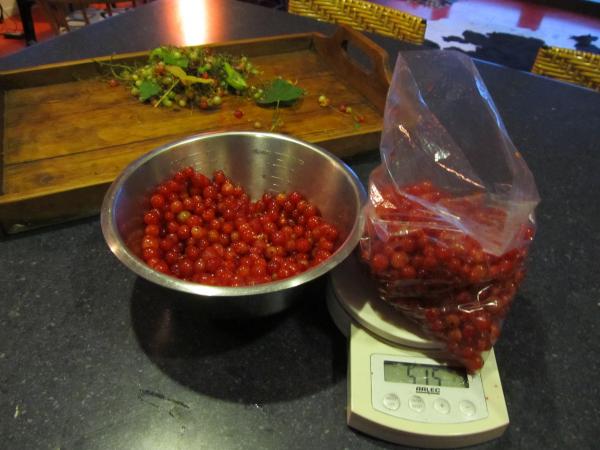
There are some fruits we just don’t get enough of down here, like citrus, so if you take a holiday up North or have friends that live in these fabled places where there are lots of lemon and grapefruit trees, get a couple of boxes delivered to you. Make batches of lemon cordial, Mediterranean preserved salted lemons, bottled lemon slices in syrup, marmalade… I freeze sliced grapefruit in plastic containers with enough in each to make a batch of marmalade as the need arises. If you need to use imported fruit get it from nearby if possible. We are only a couple of hours drive from Central Otago, and we go there in summer a lot and try to come back each time with a few buckets or boxes of something edible such as organic apricots, peaches, cherries, nuts, or wild thyme. Food in season which you have preserved in some way yourselves, is cheap and will keep your money where it should be, in your own pocket, or the pockets of local people.
Most of what we eat is vegetables, so the growing of these will take a major part of your space and time budget. There are just a couple of permanent vegetable plots you will need. A plot for scarlet runner beans, as they are perennials, and a plot for asparagus. We have an asparagus bed about the size of a single bed and this gives two of us enough asparagus for regular meals in spring.
The quantity of any type of vegetable that you grow depends on how much you eat and when. For instance, cabbages: if you only eat cabbage once a week and use quarter of a cabbage at a time, and you hardly ever eat it in summer, don’t plant them for summer. Grow a small variety to mature in autumn and some to stand over the winter until spring and only plant a few at intervals. Think about quantities by breaking it down into meals. Garlic is essential all year-round. We use a couple of cloves a day. Say there are eight cloves in a bulb of garlic; therefore we would use a bulb every four days. That is 91 cloves we would need to plant to get 91 bulbs for a year, and round it up to an even 100 to account for losses and add another 15 to cover next years crop. Keep in mind saving seed for shallots too. Replant your biggest and best to improve your crop each year. Save the seed from the best pumpkin which keeps the longest.
Pumpkins take quite a bit of space, but only a bit of it (where the roots are) needs to be actual prime garden space. They can trail away over a bank or a bit of rough ground. You will probably only get a couple of pumpkins per plant, so put in quite a few. I aim for about 16 pumpkins for two people by planting maybe 8 to 10 plants and some butternuts.
Green peas are a challenge. The amount of work it takes to grow, pick pod and freeze a kilo of peas by hand is huge compared to the appreciation you get from a generation of people raised with $3 bags of bought peas readily available. When I do freeze peas, I do it by putting a small handful of blanched peas into each bag. This method works when freezing broad beans and green beans, too. You need heaps of pea plants to get a few decent sized meals, so plant 30 plants at a time, and 30 more a few weeks later, with good netting for them to climb on. They are not like beans which wind around a pole or string, but have little tendrils which reach out a grab as they grow.
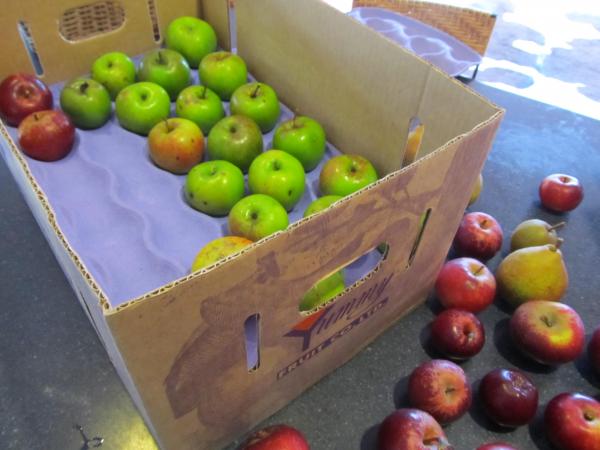
A couple of rows of scarlet runners will feed a family green beans fresh all summer, green beans frozen all winter, and some dried beans for chili as well. They are amazingly prolific. We have been growing a lot more of the climbing French type beans, choose the seeds for their ability to climb. One variety in particular I am growing about 16 plants of, four to a wigwam, each wigwam made from four long bamboo sticks. They grow about two metres tall, so maybe something longer would be better. I am not sure of the name of these beans, but something which looks very similar has recently been added to the Kings’ seed catalogue under the name “Jackson wonder pole bean”. They are a wonder though. Eat them green, frozen or let them dry and they are a delicious little lima type bean and very prolific for the space. Can you have too many beans in your garden? No, I think not.
Let what needs eating in the cupboard or the garden dictate what you cook and eat. Planning a meal should start with a trip round the garden, and a mental run through what you have stored. That way nothing will be wasted. Check over stored vegetables, e.g. when you are getting out an onion, shallots or potatoes have a look over your stores and always use the ones on their way out first. When you are choosing a pumpkin, look them all over for blemishes. It’s the opposite, I suppose, to market shopping. A good place to store root crops is important. Modern houses are mostly too warm inside. A secure area of shelves in your garage would be good if it’s dry, cool, has a bit of air circulation, and no rodents.
A glasshouse will enable you to grow a heap of Mediterranean vegetables such as tomatoes, aubergine, capsicum, chile, basil, gherkins, and cucumbers. This expands your food repertoire massively and provides a dry sunny place to dry things in autumn and to plant tubs full of salads for the winter months. We also use ours to get seedlings started early in spring, safe from the risk of frost.
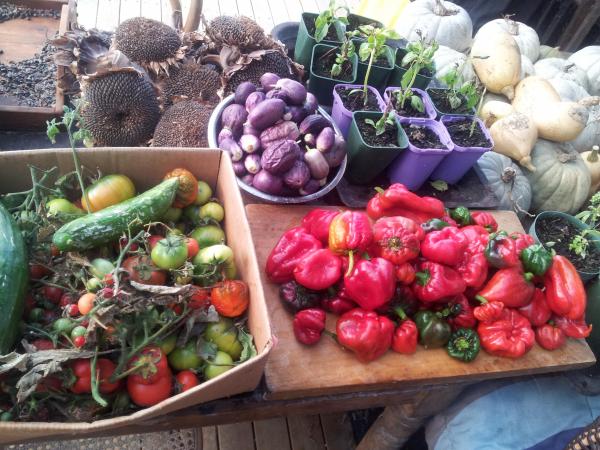
Just three gherkin plants, if you pickle a small batch every few days, as they get to a good size, will keep you in gherkins for a year. Two or three cucumbers will be a generous supply, and the more tomatoes the merrier, but not too many or your glasshouse will suffer from overcrowding and health problems. I bottle pasta sauce and pizza base sauce in small preserving jars, using whatever there is a glut of, while I have tomatoes to preserve with it. This is a good way to use excess zucchini too. Bottles of pickled bean salad are a brilliant way to store cucumber, onions, green beans, aubergine, capsicum, celery… So as you can see, planning food for a year is as much about storage as it is about planning and growing.
Every time you finish a row of vegetables in the garden, dig that patch over, compost it and get something else in that space which fits with your crop rotation. Keep your garden working, but don’t forget to leave space for things you have coming up which need to be planted. Make room in autumn for your new broad bean patch, your garlic and shallot patches. If in doubt throw in a wee row of radishes or some salad plants.
Every time you eat a meal, look it over and praise yourself for the parts of it you grew yourself. Look at what you have had to buy and investigate whether you can grow it.
Experiment with new plants, new varieties, new ways of preserving. Providing food for yourself is a lot of hard work. It is no surprise that preserving is a social activity among some cultures. It needs to be social, or you will feel like all your spare time goes into food production, and there is no time to party. Oh, and when you get the last of your crops stored in early winter, put the hoe down, and party. I think that may have been what the winter solstice celebration was invented for.